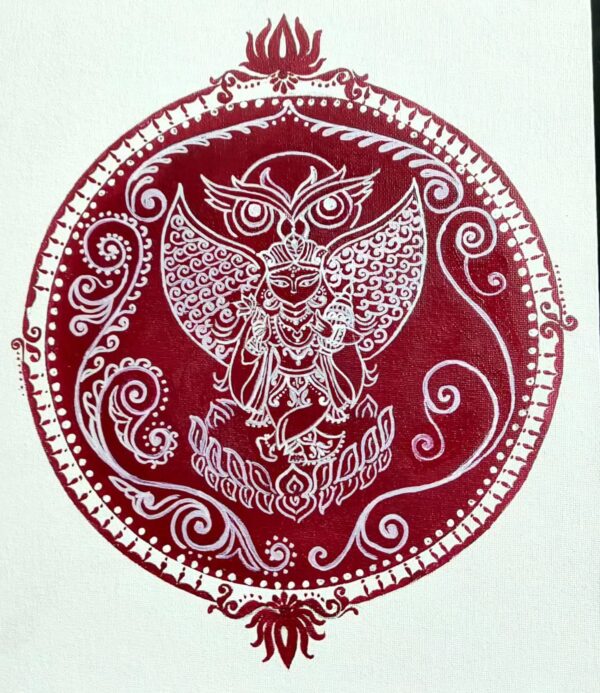Lokkhi Sora – Iconography and symbolism of Laxmi Part 2

One of the forms of Ma Lokkhi is the painted sora, a terracotta plate that is used to cover pots of water or paddy. The smooth convex side of the sora is painted with Lokkhi patachitra and she is worshipped as the Goddess. Yet another representation that needs no spiritual broker in between.
Sora has a spiritual belief attached to itself in the Bengali agrarian society. The convex surface represents the surface of the earth – Vasundhara and it’s use to cover brimming pots equates it to a pregnant woman, thus establishing it’s relationship with agrarian and human fertility. Symbolisms that are essential part of Lokkho iconography.
It is believed that the practice of worshipping Her as a painted sora, and the practice of sora chitra originated in Dhaka – Faridpur – Manikganj, by the Rudrapal artisanal class, most of whom relocated to Taherpur after partition. The religious/social significance of sora goes beyond Lokkhi pujo, as they are significant in both Hindu and Muslim communities. Based on the icons, they are classified as Lokkhi sora, Antur (natal) sora, Muharram sora, etc.
The traditional Lokkhi sora too differs in iconography based on region and communities who used these. It is believed that at one point there were thirteen different kinds of Lokkhir Sora in Bengal. I don’t know of all the thirteen, but let me describe the ones I know of.
The Dhakai sora has variations..The ‘Eklokkhi sora’ has sole figure of Ma Lokkhi in the middle with two lotuses flanking her on either sides, and her owl near her feat. Then there are ones with pair of Lokkhi figures – ‘Joralokkhi sora’ or five figures, ‘Panchlokkhi sora’. ‘Teen putul sora’ has Lokkhi in between, with her companions, Jaya and Bijaya on either sides. Her owl is next to her feet. Lokkhi is always seated on a boat in the Dhakai sora, an iconography symbolic of the regions ancient seafaring history.
The ‘Faridpuri sora’ has Lokkhi-Narayan or Radha-Krishna on the top; Lokkhi, Jaya and Bijaya on a boat in the middle, and her owl and a peacock at the bottom, denoting the dominance of the Vaishnav community in the region.
Daulatpur had a distinct white background, ‘Sada sora’ which had the sole figure of Ma Lokkhi with her owl. These could further be Eklokkhi or ‘Ekchokha sora’, that had a profile painting of Lokkhi Debi. Besides these, there were the Gajalokkhi sora, where she has four arms, sits on a lotus and has two elephants flanking her; and the Lokkhi-Saraswati sora, with Ma Sarswati painted in white and Ma Lokkhi in yellow.
The distinct but rare ‘Ganaki sora’ with its red background is made by the Ganak community or astrologers /sculptors. It has a Ma Durga with all her weapons, and her four children as the larger central piece, and Lokkhi in the bottom panel.
One of the finest and almost extinct now is the exquisite Sureswari sora, with its fine line drawing that originated in the Sureswar village of Faridpur. A Sureswari sora has Shiv on the top panel, Durga with her family in ‘panch chala’ or five different panels in the middle and Lokkhi in the bottom panel. The fine brushwork is similar to the Ganjifa cards of Odisha and Bengal.
These variations came about from sectarian religious beliefs – Shaiva, Shakta and Vaishnav, and also from associations of livelihood of the communities that made/used them. The colours and the accompanying painted embellishments were pure artistic expression of the Bengal chitrakar, in keeping with essential spiritual symbols of Lokkhi, and of all spiritual endeavours – shree and srijon – aesthetics/beauty and creativity. Aspects that lead us to the significance of the alpona and prasad offered to Her!
More on that on the last part of my Ma Lokkhi’s iconography and symbolism.

